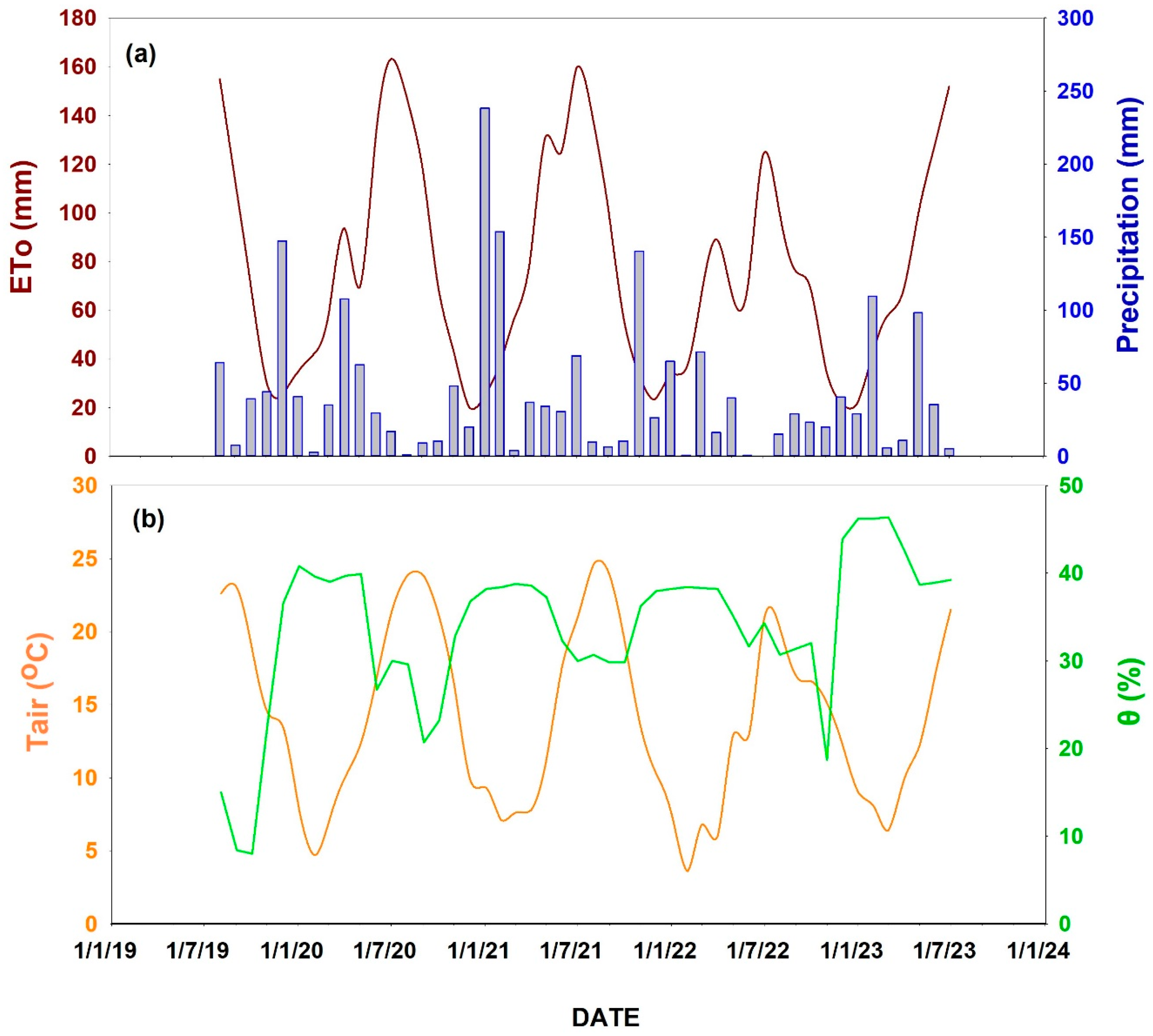Woody Species Dynamics in the Priority Habitat 91E0* in Nestos, Greece †
Abstract
1. Introduction
2. Materials and Methods
2.1. Study Area
2.2. Environmental Variables
2.3. Tree Species Dynamics
3. Results
3.1. Environmental Variables
3.2. Tree Species Dynamics
4. Concluding Remarks
Author Contributions
Funding
Institutional Review Board Statement
Informed Consent Statement
Data Availability Statement
Acknowledgments
Conflicts of Interest
Abbreviations
| UNEP | United Nations Environment Programme |
| DBH | Diameters at Breast Height |
| ETo | Evapotranspiration |
References
- Mallinis, G.; Emmanoloudis, D.; Giannakopoulos, V.; Maris, F.; Koutsias, N. Mapping and interpreting historical land cover/land use changes in a Natura 2000 site using earth observational data: The case of Nestos delta, Greece. Appl. Geogr. 2011, 31, 312–320. [Google Scholar] [CrossRef]
- Avramidou, E.V.; Korakaki, E.; Malliarou, E.; Solomou, A.D.; Mantakas, G.; Karetsos, G. First Report and Genetic Analysis of the Invasive Species A. fruticosa L. in Greece: A Combined Genetic and Regeneration Study. Ecologies 2023, 4, 627–635. [Google Scholar] [CrossRef]
- Korakaki, E.; Koulelis, P.; Solomou, A.; Karetsos, G.; Proutsos, N.; Avramidou, E.; Kaoukis, K.; Ioannidis, K.; Georgiadis, C. Woody species composition, stand structure and growth dynamics of the habitat 91E0*—alluvial forest—in Nestos, Greece. In Recent Advances in Environmental Science from the Euro-Mediterranean and Surrounding Regions, 3rd ed.; Ksibi, M., Negm, A., Hentati, O., Ghorbal, A., Sousa, A., Rodrigo-Comino, J., Panda, S., Velho, J.L., El-Kenawy, A.M., Perilli, N., Eds.; EMCEI 2021; Advances in Science, Technology & Innovation; Springer: Cham, Switzerland, 2024. [Google Scholar] [CrossRef]
- Proutsos, N.; Korakaki, E.; Bourletsikas, A.; Karetsos, G.; Tsagari, K.; Georgıadis, C. 50-year precipitation trends in Nestos Delta-Natura 2000 site. In Proceedings of the 6th International Conference of Environmental Science and Technology, CEST 2019, Rhodes, Greece, 4–7 September 2019. [Google Scholar]
- Bailey, R.L.; Dell, T.R. Quantifying diameter distributions with the Weibull function. For. Sci. 1973, 19, 97–104. [Google Scholar] [CrossRef]
- Hafley, W.L.; Schreuder, H.T. Statistical distributions for fitting diameter and height data in even-aged stands. Can. J. For. Res. 1990, 4, 481–487. [Google Scholar] [CrossRef]
- Pedashenko, H.P.; Apostolova, I.I.; Vassilev, K.V. Amorpha fruticosa invasibility of different habitats in lower Danube. Phytol. Balc. 2012, 18, 285–291. [Google Scholar]
- Anačkov, G.; Rat, M.; Radak, B.; Igić, R.; Vukov, D.; Rućando, M.; Krstivojević, M.; Rad-ulović, S.; Cvijanović, D.; Milić, D.; et al. Alien invasive neophytes of the southeastern part of the Pannonian plain. Cent. Eur. J. Biol. 2013, 8, 1032–1043. [Google Scholar] [CrossRef]
- Batanjski, V.; Batrićević, A.; Purger, D.; Alegro, A.; Jovanović, S.; Joldžić, V. Critical legal and environmental review on Ramsar convention in protection from invasive plant species—An example of the Southern Pannonia region. Int. Environ. Agreem. 2016, 16, 833–848. [Google Scholar] [CrossRef]
- Todorovic, M.; Karic, B.; Pereira, L.S. Reference evapotranspiration estimate with limited weather data across a range of Mediterranean climates. J. Hydrol. 2013, 481, 166–176. [Google Scholar] [CrossRef]


| Species | Basal Area (m2 ha−1) |
|---|---|
| Populus nigra | 42.28 |
| Platanus orientalis | 32.40 |
| Populus alba | 12.69 |
| Salix alba | 11.35 |
| Alnus glutinosa | 6.84 |
| Acer negundo | 3.78 |
| Robinia pseudoacacia | 2.17 |
| Prunus cocomilia | 1.49 |
| Sabucus nigra | 0.36 |
| Morus alba | 0.26 |
| Celtis australis | 0.18 |
| Ficus carica | 0.16 |
| Cornus saguinea | 0.12 |
Disclaimer/Publisher’s Note: The statements, opinions and data contained in all publications are solely those of the individual author(s) and contributor(s) and not of MDPI and/or the editor(s). MDPI and/or the editor(s) disclaim responsibility for any injury to people or property resulting from any ideas, methods, instructions or products referred to in the content. |
© 2025 by the authors. Licensee MDPI, Basel, Switzerland. This article is an open access article distributed under the terms and conditions of the Creative Commons Attribution (CC BY) license (https://creativecommons.org/licenses/by/4.0/).
Share and Cite
Korakaki, E.; Koulelis, P.P.; Solomou, A.D.; Avramidou, E.V.; Karetsos, G.; Mantakas, G.; Kaoukis, K.; Georgiadis, C.; Chatzipavlis, N. Woody Species Dynamics in the Priority Habitat 91E0* in Nestos, Greece. Proceedings 2025, 117, 28. https://doi.org/10.3390/proceedings2025117028
Korakaki E, Koulelis PP, Solomou AD, Avramidou EV, Karetsos G, Mantakas G, Kaoukis K, Georgiadis C, Chatzipavlis N. Woody Species Dynamics in the Priority Habitat 91E0* in Nestos, Greece. Proceedings. 2025; 117(1):28. https://doi.org/10.3390/proceedings2025117028
Chicago/Turabian StyleKorakaki, Evangelia, Panagiotis P. Koulelis, Alexandra D. Solomou, Evangelia V. Avramidou, Georgios Karetsos, Georgios Mantakas, Konstantinos Kaoukis, Christos Georgiadis, and Nikolaos Chatzipavlis. 2025. "Woody Species Dynamics in the Priority Habitat 91E0* in Nestos, Greece" Proceedings 117, no. 1: 28. https://doi.org/10.3390/proceedings2025117028
APA StyleKorakaki, E., Koulelis, P. P., Solomou, A. D., Avramidou, E. V., Karetsos, G., Mantakas, G., Kaoukis, K., Georgiadis, C., & Chatzipavlis, N. (2025). Woody Species Dynamics in the Priority Habitat 91E0* in Nestos, Greece. Proceedings, 117(1), 28. https://doi.org/10.3390/proceedings2025117028










